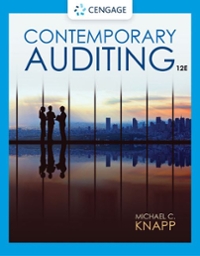Cornelius Vander Starr wanted to see the world. In 1918, the 26-year-old Californian emptied his bank account
Question:
Cornelius Vander Starr wanted to see the world. In 1918, the 26-year-old Californian emptied his bank account to purchase a one-way ticket to the Far East on a steamship.
After "bumming around" Japan for several months, Vander Starr traveled to Shanghai, China, where he landed a job working for an insurance company. Within a short period of time, Vander Starr realized that selling insurance was a low overhead business that was ideally suited for a young entrepreneurial type like himself, so he quit his job and set up his own insurance agency, American Asiatic Underwriters.
Vander Starr's business grew rapidly. By the time of his death in the late 1960s, Starr's one-man firm had become a multibillion-dollar international conglomerate with operating units in Europe, Latin America, the Middle East, and the United States.
The Starr Foundation that he created before his death ranks among the world's largest philanthropic organizations.
In 1948, the Chinese civil war forced Vander Starr to relocate his company's headquarters from Shanghai to New York City. As he neared retirement, Vander Starr chose his protégé, Maurice "Hank" Greenberg, to replace him as his company's chief executive officer. During the early 1960s, Greenberg had revamped the company's business model. Instead of focusing on selling life insurance and other insurance products for individuals, Greenberg convinced Starr that the company's principal line of business should be insurance and other financial services products designed for large corporations. In 1969, Greenberg took the company, which had been renamed American International Group, Inc. (AIG), public by listing its stock on the New York Stock Exchange.
Greenberg would serve as AIG's top executive for nearly four decades. Under his leadership, the company became known worldwide for the new and innovative financial services products that it continually developed and the aggressive methods that it used to market those products. These efforts produced impressive financial results for the company. By the turn of the century, AIG was one of the 10 largest companies in the United States and among the 20 largest companies worldwide.
In early 2001, a group of AIG executives came up with an idea for a new financial service that they believed would appeal to a wide range of large corporations. This service would involve AIG creating customized "special purpose entities" or SPEs for such companies. An SPE is typically a limited partnership that two or more companies join together to form. Since an SPE is an unconsolidated subsidiary, a company can download or transfer underperforming assets and related liabilities to that entity to improve its apparent financial condition. This "balance sheet management feature" of SPEs was the principal selling point that AIG intended to rely on in marketing its new services
In fact, many large corporations were already using SPEs "to perform cosmetic surgery on their balance sheets."1 Enron Corporation, a large Houston-based energy company, was among the most prolific users of SPEs.2 Enron had significantly improved its apparent financial condition by "hiding" distressed assets and much of its outstanding debt in hundreds of SPEs that it had created. AIG's management was convinced that, unlike Enron, most companies did not have the in-house expertise to develop their own SPEs.
Questions
1. Is it ethical for a CPA or CPA firm to help companies "manage" their reported earnings and financial condition? In responding to this question, first, assume that the CPA or CPA firm is serving as a consultant, and then assume that the CPA or CPA firm is serving as the given entity's independent auditor. Defend your answers.
2. When a dispute arises between an audit client and its auditor regarding the proper accounting treatment for a transaction or other item, the audit client will sometimes retain another accounting firm to issue a report, previously known as a SAS No. 50 report, on the proper accounting treatment for the given item [see AS 6105 of the PCAOB auditing standards and AU-C Section 915 of the AICPA Professional Standards]. Identify the potential ethical dilemmas that may result from allowing accounting firms to issue such reports to non-audit clients.
Step by Step Answer:






